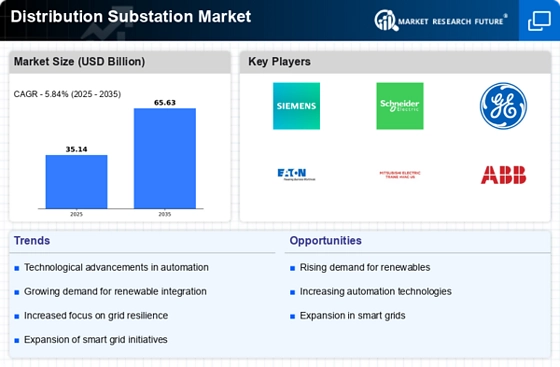Rising Demand for Electricity
The increasing demand for electricity across various sectors is a primary driver for the Distribution Substation Market. As urban populations grow and industrial activities expand, the need for reliable and efficient power distribution becomes paramount. According to recent data, electricity consumption is projected to rise by approximately 2.5% annually, necessitating the enhancement of existing distribution networks. This trend compels utility companies to invest in new substations and upgrade existing ones to meet the escalating demand. Furthermore, the shift towards electrification in transportation and heating sectors further amplifies this demand, indicating a robust growth trajectory for the Distribution Substation Market.
Urbanization and Population Growth
Urbanization and population growth are pivotal factors influencing the Distribution Substation Market. As more people migrate to urban areas, the demand for electricity in these regions escalates. This urban influx necessitates the expansion and modernization of electrical infrastructure, including substations. Recent statistics suggest that urban areas are expected to house over 68% of the global population by 2050, intensifying the need for efficient power distribution systems. Utilities are thus compelled to invest in new substations and upgrade existing ones to ensure reliable electricity supply. This trend underscores the critical role of urbanization in driving the Distribution Substation Market.
Government Initiatives and Regulations
Government policies and regulations play a crucial role in shaping the Distribution Substation Market. Many governments are implementing stringent regulations aimed at improving energy efficiency and reducing carbon emissions. For instance, incentives for renewable energy projects often include provisions for upgrading distribution infrastructure. This regulatory environment encourages investments in modern substations that can accommodate renewable energy sources. Additionally, government funding for infrastructure projects is expected to increase, further driving the need for advanced distribution substations. As a result, the Distribution Substation Market is likely to experience growth fueled by supportive governmental frameworks.
Increased Investment in Renewable Energy
The Distribution Substation Industry. As countries commit to reducing their carbon footprints, investments in solar, wind, and other renewable energy projects are surging. This transition necessitates the development of robust distribution networks capable of integrating these variable energy sources. Data indicates that renewable energy capacity is expected to grow substantially, leading to an increased need for substations that can manage this influx. Consequently, the Distribution Substation Market is poised for growth as utilities adapt their infrastructure to accommodate the changing energy landscape.
Technological Advancements in Substation Design
Technological innovations are transforming the Distribution Substation Market, leading to more efficient and reliable systems. The integration of smart grid technologies, automation, and advanced monitoring systems enhances the operational capabilities of substations. For example, the adoption of digital substations, which utilize advanced sensors and communication technologies, is on the rise. These innovations not only improve the reliability of power distribution but also facilitate real-time monitoring and management of electrical networks. As these technologies become more prevalent, they are expected to drive significant investments in the Distribution Substation Market, as utilities seek to modernize their infrastructure.


















Leave a Comment